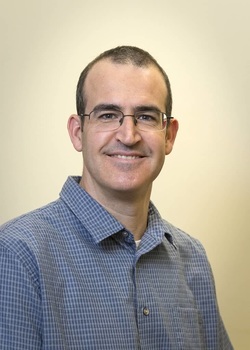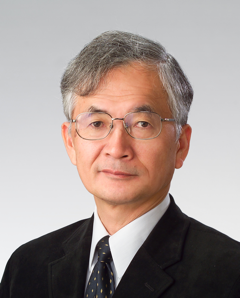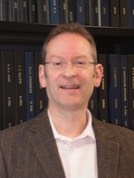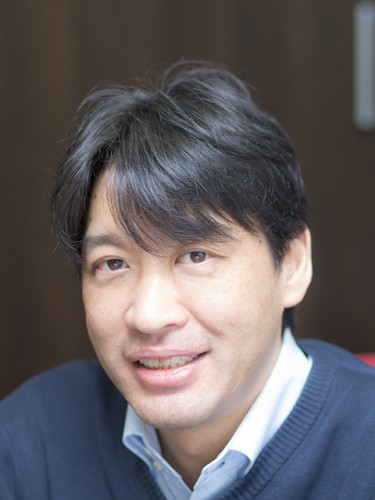

Friday, Dec. 7, 3:30 - 5:00pm, WEL 2.122 
Associate Professor of Chemistry
University of Wisconsin - Madison
Our research program aims to design molecular-level reactivity into macromolecular systems that can respond to external stimuli. This has provided a forum in which our teams push the boundaries of polymer chemistry and collectively integrate new reaction development, precision synthesis, materials science, and engineering. In the design of stimuli-responsive materials and systems, we approach problems with the mindset that chemistry is the “central science.” Accordingly, we emphasize discovery of more efficient synthetic techniques, establishment of structure-reactivity principles, and correlations between molecular structure and bulk (macroscopic) materials properties. Importantly, our goals and fullest potential are only realized through intensive collaborative efforts that integrate our breakthroughs in polymer chemistry with cutting-edge mechanical, chemical, and biological engineering. In each of the four main focus areas , there are examples of fundamental research challenges that have solutions rooted in new chemical breakthroughs, as well as collaborative efforts to transition from fundamental to applied research.
h-index: 30 Total Articles: 55 Total Citations: 2665 (Web of Science, Nov. 2018)
h-index: 32 Total Citations: 3288 (Google Scholar Citations, Nov. 2018)
Friday, Nov. 30, 3:30 - 4:30pm, WEL 2.122 
Associate Professor of Chemistry
Temple University
Research in the Andrade Laboratory is inspired by Nature’s unrivaled capacity to produce myriad, complex chemical structures that possess unique biological activities. We develop novel synthetic methodology to efficiently prepare structures of interest (i.e., synthesis), interrogate their molecular mechanisms of action in biological systems (i.e., chemical biology), and apply our findings to develop therapeutics (i.e., medicinal chemistry).
Current projects include the discovery of (1) Synthesis of novel antibiotics that address the problem bacterial resistance and (2) indole alkaloids that combat cancer via unique mechanisms of action.
h-index: 16 Total Articles: 44 Total Citations: 1000 (Web of Science, Nov. 2018)
Monday, Nov. 5, 3:30 - 5:00pm, WEL 2.122
Associate Professor of Chemistry
University of Southern California
New Approaches to Hydride Manipulation
We are developing new catalysts and conditions to manipulate hydrides such as various C-H and other X-H bonds. Particularly, we're interested in coordinatively directed hydride abstraction and new reactions for complex molecule synthesis that feature C-H activation. To achieve these goals, we will employ strategies of catalyst design, thus exploring novel organometallic and coordination chemistry, and target-oriented new organic reaction development.
Mechanistic Studies of the Shvo Bifunctional Catalyst. A major emphasis of our group has been to understand the reactivity of organometallic complexes that interact with target substrates through both their metal and ligand.
New Catalyst Development. Using the Shvo chemistry as a template, we have designed a new Ru, B scaffold for manipulation of hydride groups. This structural motif gave us the first example of an agnostic bond that is strong enough to displace a ligand from a coordinately saturated metal center, 8. We measured the thermochemistry of this displacement by NMR inversion recovery.
Dehydrogenation of Ammonia Borane. We have applied our catalyst systems to a number of reactions, most notably the dehydrogenation of ammonia borane, a prospective hydrogen storage material.
Mechanistic Elucidation. We are uncovering the mechanistic details of ammonia borane dehydrogenation as part of our ongoing project to understand and utilize hydride transfer reactions that are catalyzed by buifunctional transition metal complexes.
Chemical Probes for Biology and Medicine
Simultaneously and synergistically with our organometallic work, we are devising conceptually novel chemical tools for research and clinical use. Along these lines, we are currently developing the first ultrasound-activated MRI contrast agent.
h-index: 22 Total Articles: 48 Total Citations: 1764 (Web of Science, Oct. 2018)
HHMI Seminar
Friday, October 26, 3:30 - 5:00pm, WEL 2.122 
Associate Professor of Chemistry
Oklahoma State University
Professor Nelson’s research emphasizes the development of new organic semiconductors - electronic materials and their application in organic electronics, sensors and bioelectronics. His program covers design and synthesis of organic semiconductors, polymer chemistry, supramolecular materials, sustainable chemistry and development of bioinspired materials, biosensors and materials for energy applications. His current research interest emphasizes on the development of new bioinspired organic semiconductors based on the natural pigment, Eumelanin.
h-index: 8 Total Articles: 16 Total Citations: 450 (Web of Science, Sep. 2018)
Anslyn Iverson Sessler Lecture
Friday, October 19, 3:30 - 6:00pm, WEL 2.122 
Professor of Chemistry
Kyoto University
Porphyrin is an intriguing π-conjugated molecule in light of its unique electrochemical and optical properties as well as a variety of its metal-complexes. For a long moment, a number of researchers have investigated the nature to create a new class of materials. On the other hand, our group has already developed our original porphyrin chemistry beyond the classical one , namely "Super" Porphyrin Chemistry. It is represented by "Discreat Giant Porphyrin Array", "Fully Conjugated Porphyrin Tape", "Expanded Porphyrin", "Subporphyrin", "Möbius Aromatic and Antiaromatic Molecules", and so on. The goal of our research is, with deepening this chemistry, to pioneer innovative π-conjugated molecules having an impact in a wide field such as organic chemistry, physical organic chemistry, coordination chemistry, and photophysical chemistry.
h-index: 81 Total Publications: 741 Total Citations: 27,382 (Web of Science, Sep. 2018)
Anslyn Iverson Sessler Lecture
Friday, October 19, 3:30 - 6:00pm, WEL 2.122
Professor of Chemistry
University of Parma
The team interests are focused on the design and preparation of functional materials, using self-assembly and molecular recognition tools. Over the years the major themes have been: macrocyclic liquid crystals, self-assembled monolayers and LB films, metal-directed self-assembly of coordination cages, supramolecular sensors and adaptive polymers.
h-index: 40 Total Articles: 175 Total Citations: 5645 (Web of Science, Sep. 2018)
h-index: 44 Total Citations: 6853 (Google Scholar, Sep. 2018)
Friday, October 8, 3:30 - 5:00pm, WEL 2.122
Associate Professor of Chemistry
Gifu University, Japan
Research interests are 1) Organic synthesis, 2) Asymmetric synthesis, and 3) Catalytic transformation of the bulk materials to the fine chemicals.
h-index: 25 Total Publications: 49 Total Citations: 1815 (Web of Science, Sep. 2018)
Distinguished Alumni Series
Friday, Sept. 28, 3:30 - 5:00pm, WEL 2.122
Director of Surfactant Development,
Center for Petroleum and Geosystems Engineering
University of Texas at Austin
Upali has commercialized several new surfactant processes. His research interests are in design, evaluation, and synthesis of surfactants. Upali pays special attention to commercial feasibility of new surfactant systems.
h-index: 13 Total Publications: 30 Total Citations: 818 (Web of Science, Aug. 2018)
Novartis Lecture
Friday, Sept. 21, 3:30 - 5:00pm, WEL 2.122 
Professor of Chemistry
University of Oxford
Our research interests are in synthetic organic chemistry and the contribution that this science can make to the fields of medicine and natural products. We concentrate on developing new methodologies for synthetic organic chemistry and asymmetric synthesis and then employing our chemistry to make biologically-important natural products.
h-index: 38 Total Publications: 162 Total Citations: 4234 (Web of Science, Aug. 2018)
Monday May 7, 3:30 - 5:00pm, WEL 2.122 
Professor of Chemistry
University of Bristol
The group’s research interests lie broadly within the area of asymmetric catalysis with a particular focus on metal-catalysed processes and their application to heterocyclic chemistry. A special emphasis is placed on the development of green processes (i.e. atom economy, step economy and selectivity).
h-index: 29 Total Publications: 61 Total Citations: 2109 (Web of Science, Apr 2018)
Distinguished Alumni Lecture
Friday, May 4, 3:30 - 5:00pm, WEL 2.122
Associate Professor
Tulane University
h-index: 26 Total Publications: 80 Total Citations: 3743 (Web of Science, Apr 2018)
Mahler Lecture
Wednesday, April 25, 3:30 - 4:30pm, WEL 2.122 
Professor
Technion - Israel Institute of Technology
h-index: 54 Total Publications: 180 Total Citations: 8610 (Web of Science, Mar. 2018)
 Highly Cited in Field: 3 papers
Highly Cited in Field: 3 papers
Rowland Pettit Centennial Visiting Professorship
Thursday, April 20, 3:30 - 5:00pm, WEL 2.122 
Professor
Nagoya University
h-index: 59 Total Publications: 257 Total Citations: 12,560 (Web of Science, Mar. 2018)
 Highly Cited in Field: 20 papers
Highly Cited in Field: 20 papers
Monday, April 16, 3:30 - 4:30pm, WEL 2.122 
Assistant Professor
Stony Brook University
PhD, UT Austin, 2008 (Krische)
ORCID: https://orcid.org/0000-0002-3055-6662
h-index: 13 Total Publications: 22 Total Citations: 1099 (Web of Science, Mar. 2018)
Friday, April 13, 3:30 - 4:30pm, WEL 2.122 
Assistant Professor
McKetta Dept. of Chemical Engineering, UT Austin
We carry out fundamental and applied research in polymer science guided by the principles of simplicity, sustainability, and relevance to key technological challenges in chemical engineering for the 21st century in energy, environment, security, and materials for healthcare. Synthesis is the primary tool that we use to answer fundamental questions, and bring to bear in applied research projects. However, modeling efforts may be used to facilitate materials design, and to provide context for the interpretation of data. Particularly, we are engaged in research efforts that create and utilize new functional and reactive polyether materials and block polymers. Newer work is built on a foundation of novel techniques for advanced copolymer structure determination and detailed mechanistic understanding which facilitate the compositional control of structure-property-processing relationships.
h-index: 24 Total Publications: 59 Total Citations: 1734 (Web of Science, Feb. 2018)
h-index: 24 Total Publications: 61 Total Citations: 1764 (Scopus, Feb. 2018)
h-index: 26 Total Citations: 2126 (Google Scholar, Feb. 2018)
Friday, March 16, 3:30 - 4:30pm, WEL 2.122 
Associate Professor
Ben-Gurion University of the Negev
Dr. Pappo's research interests are focused on organic synthesis, with particular emphasis on mechanistically driven catalyst design for selective oxidative coupling reactions.
h-index: 12 Total Publications: 29 Total Citations: 548 (Web of Science, Feb. 2018)
h-index: 12 Total Publications: 29 Total Citations: 572 (Scopus, Feb. 2018)
h-index: 14 Total Citations: 640 (Google Scholar Citations, Feb. 2018)
Monday, February 19, 1:00pm - 2:00pm, NHB 1.720 
Assistant Professor of Chemistry
Brigham Young University
Research interests include: Organic synthesis, catalysis, natural product total synthesis, inorganic synthesis, polymer chemistry, biocatalysis.
ORCID: https://orcid.org/0000-0003-3914-5752
h-index: 11 Total Publications: 18 Total Citations: 517 (Web of Science, Feb. 2018)
h-index: 11 Total Publications: 19 Total Citations: 536 (Scopus, Feb. 2018)
Vista Lecture
Friday, February 16, 3:30pm - 5:00pm, WEL 2.122 
Professor of Chemistry
University of Glasgow
Research in the Cronin Group is motivated by the fascination for complex chemical systems, and the desire to construct complex functional molecular architectures that are not based on biologically derived building blocks.
ORCID: https://orcid.org/0000-0001-8035-5757
h-index: 59 Total Publications: 324 Total Citations: 14,409 (Web of Science, Jan. 2018)
 Highly Cited: 7 papers
Highly Cited: 7 papers
Faculty Recruiting Seminar 
Wednesday, February 14, 3:30pm - 4:30pm, WEL 2.122
Postdoctoral Researcher, Chemical/Bioengineering
Caltech
PhD, Yale, 2015
Arnold Group: Enzyme activity; Target-oriented biocatalysis; Protein engineering.
ORCID: https://orcid.org/0000-0003-0498-7597
h-index: 8 Total Citations: 182 (Google Scholar Citations, Jan. 2018)
Faculty Recruiting Seminar
Monday, February 12, 3:30pm - 5:00pm, WEL 2.122
Postdoctoral Fellow, Inorganic Chemistry
ETH Zurich
PhD, Michigan, 2015
Copéret Group: The controlled functionalization of surfaces is essential for defining the properties of materials used in catalysis, imaging, or microelectronics. Our group works on the surface chemistry of oxides, metallic nanoparticles, and hybrid organic-inorganic materials. In particular, the focus of our research is to master the molecular structures and related properties of supported single-site and nanoparticle catalysts. More recently, we have extended these strategies to applications involving imaging (luminescence and nuclear magnetic resonance) and microelectronic devices. Since our research requires detailed molecular understanding of the surface chemistry of materials, we use a combination of spectroscopic methods (IR, UV-Vis, XPS, XAFS, EPR, and solid-state NMR, etc.), computational chemistry (on molecular and periodic systems), and testing the properties of the materials. The overarching goal is to develop catalysts and devices through rational design.
ORCID: http://orcid.org/0000-0003-3501-8502
h-index: 6 Total Publications: 7 Total Citations: 252 (ResearcherID, Jan. 2018)
Friday, February 9, 3:30pm - 5:00pm, WEL 2.122
Assistant Professor of Chemistry
University of North Carolina
Microbial small molecules, also known as secondary metabolites, were well known for their impressive therapeutic properties and diverse medicinal applications. They also serve important biological functions including self-defense and cell-cell signaling for the producing microbes. However, the physiological roles of many secondary metabolites remain poorly understood. Next-generation genome sequencing revealed that microbes harbor many uncharacterized biosynthetic operons, sometimes up to 25% of their genomes, for the biosynthesis of small molecules. It is unclear what molecules these operons make or what their functions are. Our lab develops genome-mining strategies to identify and characterize new small molecules from microbes. We are particularly interested in microbes that are associated with eukaryotes and their small molecules that are likely involved in microbe-microbe or microbe-host interactions. Our goal is to explore and exploit the biological functions and therapeutic applications of these molecules.
ORCID: http://orcid.org/0000-0002-8019-8891
h-index: 9 Total Publications: 14 Total Citations: 595 (Web of Science, Jan. 2018)
Faculty Recruiting Seminar
Wednesday, Feb. 7, 2:00 - 3:00pm, NHB 1.720
Postdoctoral Researcher
UC Santa Barbara
PhD, Univ. of Massachusetts Amherst, 2015
Zak's research efforts have focused on synthesis and characterization of hydrophilic conjugated polymers, and their integration into organic photovoltaics, as well as the design of novel compounds for organic light emitting diodes, in-situ analysis of photochemical transformations, and 3D printing of soft materials. Future research will be interdisciplinary in nature, including aspects of synthetic chemistry, materials science, and engineering and will expand upon knowledge gained during past research experiences. Tailored templating and photochemical approaches will be studied to generate well-defined soft materials and composites with interesting (opto)electronic and mechanical properties, with applications spanning bioelectronics, flexible electronics, and additive manufacturing.
Publications (Google Scholar Citations)
h-index: 11 Total Citations: 679 (Google Scholar Citations. Feb. 2018)
h-index: 12 Total Publications: 34 Total Citations: 602 (Web of Science, Feb. 2018)
 Web of Science Highly Cited Paper: Page, ZA et al. Fulleropyrrolidine interlayers: tailoring electrodes to raise organic solar cell efficiency. Science, 346(6208), 2014, 441-444. DOI: 10.1126/science.1255826
Web of Science Highly Cited Paper: Page, ZA et al. Fulleropyrrolidine interlayers: tailoring electrodes to raise organic solar cell efficiency. Science, 346(6208), 2014, 441-444. DOI: 10.1126/science.1255826
Faculty Recruiting Seminar
Wednesday, January 31, 3:30pm - 4:30pm, WEL 2.122
Postdoctoral Fellow, Chemistry & Chemical Biology
Harvard University
Eric Jacobsen Lab Research Web Page
PhD, Wisconsin, 2015
Jacobsen Lab: Our program is dedicated to the discovery of practical catalytic reactions, and to the application of state-of-the art mechanistic and computational techniques to the analysis of those reactions. Over the past several years, we have sought and identified new classes of chiral catalysts, and several of these have found widespread application in industry and academia. These include metal-salen complexes for asymmetric epoxidation, conjugate additions, and hydrolytic kinetic resolution of epoxides; copper-diimine complexes for asymmetric aziridination; chromium-Schiff base complexes for a wide range of enantioselective pericyclic reactions; and organic hydrogen bond-donor catalysts for activation of neutral and cationic electrophiles. Our mechanistic analyses of these catalytic systems have helped uncover general principles for future catalyst design, including electronic tuning of enantioselectivity, cooperative homo- and hetero-bimetallic catalysis, hydrogen-bond donor asymmetric catalysis, and anion binding catalysis.
h-index: 6 Total Publications: 6 Total Citations: 1044 (Web of Science, Dec. 2017)
 Highly Cited Publication: Wendlandt, AE; Suess, AM; Stahl, SS. Copper-catalyzed aerobic C-H functionalizations: trends and mechanistic insights. Angew. Chem. Int. Ed. 50(47), 2011, 11062-11087. DOI: 10.1002/anie.201103945
Highly Cited Publication: Wendlandt, AE; Suess, AM; Stahl, SS. Copper-catalyzed aerobic C-H functionalizations: trends and mechanistic insights. Angew. Chem. Int. Ed. 50(47), 2011, 11062-11087. DOI: 10.1002/anie.201103945
The Seminars page is brought to you by the University Libraries. Our intent is to provide a quick profile of our guest speakers, links to their research group sites, recent publications, author metrics, and other information to enhance your engagement with the guests.

This work is licensed under a Creative Commons Attribution-NonCommercial 4.0 Generic License.